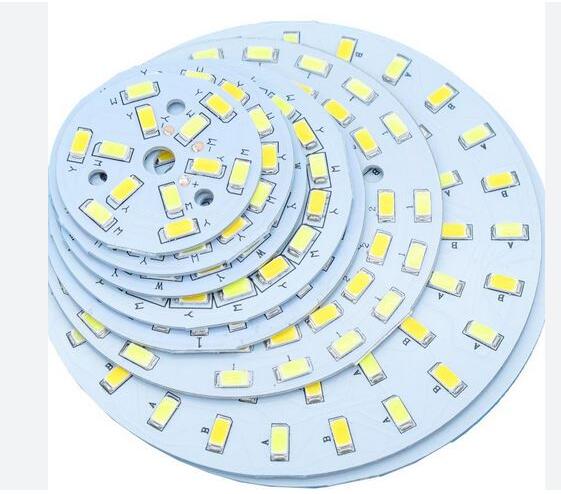Led lighting aluminum PCB is composed of a thin layer of dielectric material that has excellent thermal conductivity but electrical insulation, sandwiched between the copper circuit layer and the aluminum PCB. The aluminum PCB effectively dissipates heat, while the dielectric layer ensures that the electronic components on the PCB are separated from the aluminum PCB.

LED aluminum PCB
This unique structure can achieve optimal thermal management, which is a key factor in high-power LED applications, as excessive heat can lead to premature failure or performance degradation.
Advantages of LED aluminum PCB
1. Improve thermal conductivity
One of the main advantages of LED lighting aluminum PCBs is their improved thermal conductivity compared to traditional PCB materials. Aluminum PCB provides better heat dissipation, helping to keep LED components at lower temperatures. This leads to a longer lifespan for LED lights and improved reliability.
2. Increase durability and stability
Compared with traditional PCB materials, LED lighting aluminum PCB is also more durable and mechanically stable. This makes them very suitable for use in harsh environments, such as outdoor lighting, industrial lighting, and high-power lighting applications. The improvement in durability and mechanical stability also enhances resistance to impact and vibration, making aluminum LED PCBs a reliable choice for demanding applications.
3. Lightweight
LED aluminum PCBs are also very lightweight, making them easy to install and handle. The weight reduction also reduces transportation costs and reduces environmental impact, making aluminum LED PCBs an environmentally friendly choice.
4. Cost-effectiveness
In addition to improving thermal conductivity and durability, LED lighting aluminum PCBs are also more cost-effective compared to traditional PCB materials. This reduces the costs for LED lighting manufacturers and end users. The lower cost combined with improved performance makes aluminum LED PCBs an attractive choice for manufacturers and consumers.
Aluminum PCBs used for LEDs typically generate high heat. This makes it very difficult to cool through traditional methods. In addition, metal-core printed circuit boards are often chosen for LED applications due to their excellent heat dissipation ability. Aluminum is commonly used to manufacture printed circuit boards that can be used for LED lights.
Aluminum PCB is a type of metal core PCB. Aluminum-based PCB is a metal-based copper-clad laminate with good heat dissipation. They are also known as aluminum circuit boards, MCPCBs (metal-clad printed circuit boards), IMS (insulated metal substrates), aluminum substrate PCBs, aluminum core PCBs, etc. They all refer to the same type of PCB. Among all metal core PCBs, aluminum PCB is the most common and popular type. The substrate is composed of an aluminum core and insulation layer, which can effectively dissipate heat, cool components, and extend the lifespan of components. At present, aluminum PCBs are considered a solution for high-power LED applications, such as LED street lights, automotive headlights, LED high beam lights, etc.
Different types of aluminum PCBs
There are three commonly used aluminum PCBs: flexible aluminum, mixed aluminum, and multi-layer aluminum PCBs, with flexible aluminum and mixed aluminum PCBs being the most commonly used in the LED lighting industry.
Flexible aluminum
In addition to good thermal conductivity, this type of aluminum PCB also has excellent insulation and flexibility because it uses ceramic filler and polyimide resin materials. It provides a high-performance connection without the use of cables, connectors, and fixtures, which does not take up too much space and can also reduce production costs. In addition, flexible aluminum PCBs have excellent strength and durability.
Mixed aluminum
It is a type of PCB that mixes non-heat-resistant materials with aluminum matrix metals. By mixing them, the circuit board has better heat dissipation performance and increases rigidity. It is cheaper than all aluminum PCBs but has poor flexibility.
Multi-layer aluminum
Composed of multiple layers of thermal conductive media, with high conductivity. However, its heat transfer efficiency is relatively low, but it can meet basic heat dissipation needs.
The LED lighting aluminum PCB adopts surface mount technology, which effectively handles thermal diffusion in the circuit design scheme; It is beneficial for reducing product operating temperature, improving product power density and reliability, extending product service life, reducing product volume, and reducing hardware and assembly costs. LED lighting aluminum PCBs are widely used in fields such as communication, power, electronics, medical equipment, mechanical equipment, lighting, etc.